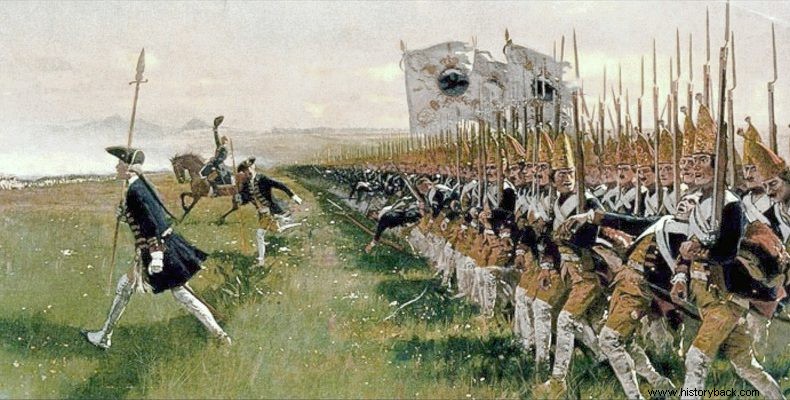
The Prussian Army during the 42 years of Frederick's rule, was the most perfect military machine in the world. The Prussian monarch himself was also the initiator of the new military doctrine of his army, which he retrieved from ancient Greek history, of which he was a fan.
Before setting out on campaign the army was organized into temporary brigade-sized formations. The army moved from march formation to battle formation at a distance of no more than 8 km. from what advanced enemy positions. The usual distance was that of 5 km, although later it was reduced to 1,000 to 1,500 meters. Of course, it also depended on the morphology of the terrain and the plan of attack.
If Frederick himself was in command then the plan was simple. Direct attack! The form of manifestation of the attack was initially classical. The Prussian Army was deployed in three lines of battle - first, second and reserve - facing the enemy and attacking him head-on. The Prussian Army, however, was numerically inferior to its opponents, and the achievement of bloody successes was beyond its capabilities. Battles like those of Mollwitz or Prague were equally painful for the victor and the vanquished.
Frederick realized that it was all too easy to win such fierce victories and ultimately lose the war for lack of men. Monolithic, full-army frontal attacks against organized enemy forces were costly in blood and did not always ensure success.
A new battle tactic had to be discovered which would enable the few Prussians to defeat, at a low "cost" in blood, their more numerous enemies. Fortunately for him, Frederick was a lover of military history, especially Greek and Roman. So he found the solution he was looking for by going back in time.
Since his army was numerically outnumbered, his only chance of success was to gain local numerical superiority, at selected points on the front and mainly opposite the flanks of the enemy line.
In this way the enemy front would break up and the Prussians would have the opportunity to sweep the opposing armies by hooking them in front and hitting them in the flanks. This tactic of economy of forces and the acquisition of local numerical superiority was of course an ancient Greek invention, the famous tactic of the Skewed Phalanx of Epaminondas and Pelopidas, the two Theban generals of the 4th century BC
This was the solution that Frederick literally dug up 2,000 years later. Based on the tactic of the oblique phalanx the army moved parallel to the enemy front and began to shift into battle formation at maximum speed. The bulk of the Prussian forces were concentrated as perpendicularly as possible to the enemy flank(s). At the same time, units of light infantry, cavalry and artillery were hooking the enemy center.
In many cases brigades of line infantry and heavy cavalry were stationed behind the light divisions in an attempt to mislead the enemy as to the exact point from which the Prussian attack would be launched.
The army was still deployed to fight in three lines. The first and the second were formed by the same number of battalions and companies. The first line of battle was separated from the second by between 200 (usually) and 500 meters. The third reserve line consisted of a few battalions of infantry and a few companies of light cavalry.
The whole battle arrangement strongly resembled that of the Byzantine Army. In many cases, especially after 1760, the battalions of the second line were not deployed in line formation, but in phalanx formation, so that they would be able to more quickly cover even the slightest breach that might be created in the first line.
As soon as the army received its order of battle, three cannon shots signaled the start of the battle. Immediately after the assembly of the heavy artillery, he would open fire on the enemy positions and concentrate his fire on selected enemy strongpoints or on pre-selected points on the enemy front against which the attack would be launched.
It was precisely against this pre-marked point of the enemy formation that they would launch, after the artillery had been prepared and the attack of part of the Prussian forces.
The other Prussian divisions would simply engage the opposing enemy units without engaging them decisively. That way even if the attack failed, most of the army would be able to retreat safely. In this way the small Prussian army achieved proud victories, such as that of Luten, in 1757, where with 35,000 men, Frederick destroyed an enemy army almost three times larger.
